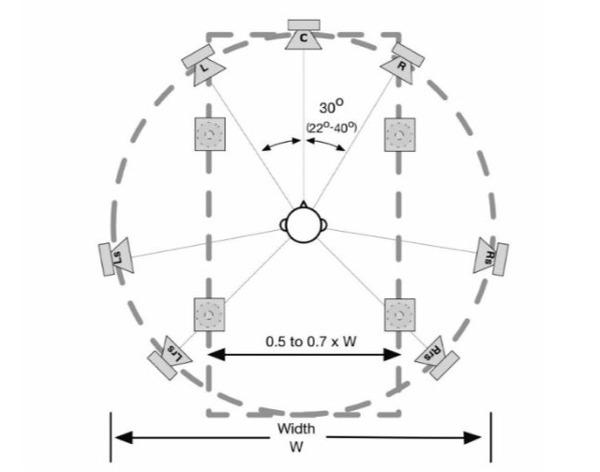Can I Use All Ceiling Speakers In an Atmos Setup?

Q I sell home cinema and A/V systems professionally and wanted to get your thoughts on the following questions. Is it possible to install a Dolby Atmos 5.1.2 or 5.1.4 configuration using only in-ceiling speakers with directional tweeters? My idea is to have the front left, center, and front right speakers in a straight parallel line close to the screen wall, and the surround speakers in the extreme rear corners of the room in-line with the front left and front right speakers. What layout would you use to arrange the Atmos ceiling speakers? My idea would be to place the four Atmos speakers in a smaller square in the room, with my sofa in the middle to get the sweetest spot. —Felix Diezel, via email
A Although installing a Dolby Atmos 5.1.2 or 5.1.4 configuration using only in-ceiling speakers is something you could do, it’s not a solution I’d advocate. From the official Dolby Atmos home theater installation guidelines: “To get the best Dolby Atmos experience, there must be separation between the listener-level speakers and overhead speakers. Installing all of the speakers in the ceiling will not give the optimal experience and is not recommended.”
What’s a listener-level speaker? In an Atmos system, those are the ones used for the main left/right, center, surround left/right, and rear left/right speaker positions — essentially, the same layout you’d use in a standard 7.1-channel surround speaker setup. Dolby’s installation guidelines further specify that listener-level speakers should all be placed at the same height — 3.9 feet, or ear-level for an average listener.
While Dolby is very specific about the requirements for listener-level speakers in Atmos systems, they’re more flexible about overhead speakers, which could be either in-ceiling, on-ceiling, or “Atmos-enabled” models. The Atmos-enabled category consists of integrated models containing both front and upward-firing driver sets, the latter meant to reproduce overhead effects by bouncing sound off the ceiling, or add-on modules with upward firing drivers that sit atop your main and rear speakers.
While an all-in-ceiling Atmos system isn’t something I’d recommend, I do have in-ceiling overhead speaker installation suggestions based on Dolby’s guidelines. For a 5.1.4 configuration, the speakers should be installed in-line with front left/right speakers, and ceiling height should ideally be between two and three times the vertical position of the front left/right speakers. The arrangement should also be centered over the listening area (see image above) and spaced to permit a 45-degree elevation angle from the overhead speakers to the main listening seat.
For a 5.1.2 setup, the same the rules apply, but the overhead pair should be positioned for a tighter elevation angle just in front of the main listening area. If it makes you feel better, the guidelines also state this: “Dolby Atmos is a highly flexible solution, so minor variations from these recommendations are unlikely to materially detract from the immersive Dolby Atmos experience.”
- Log in or register to post comments























































